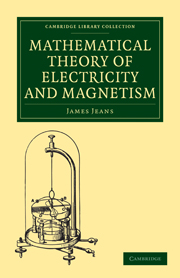Book contents
- Frontmatter
- Preface
- Contents
- Introduction
- ELECTROSTATICS AND CURRENT ELECTRICITY
- CHAP. I Physical Principles
- CHAP. II The Electrostatic Field of Force
- CHAP. III Conductors and Condensers
- CHAP. IV Systems of Conductors
- CHAP. V Dielectrics and Inductive Capacity
- CHAP. VI The State of the Medium in the Electrostatic Field
- CHAP. VII General Analytical Theorems
- CHAP. VIII Methods for the Solution of Special Problems
- CHAP. IX Steady Currents in Linear Conductors
- CHAP. X Steady Currents in Continuous Media
- MAGNETISM
- ELECTROMAGNETISM
- INDEX
CHAP. VI - The State of the Medium in the Electrostatic Field
from ELECTROSTATICS AND CURRENT ELECTRICITY
Published online by Cambridge University Press: 05 August 2011
- Frontmatter
- Preface
- Contents
- Introduction
- ELECTROSTATICS AND CURRENT ELECTRICITY
- CHAP. I Physical Principles
- CHAP. II The Electrostatic Field of Force
- CHAP. III Conductors and Condensers
- CHAP. IV Systems of Conductors
- CHAP. V Dielectrics and Inductive Capacity
- CHAP. VI The State of the Medium in the Electrostatic Field
- CHAP. VII General Analytical Theorems
- CHAP. VIII Methods for the Solution of Special Problems
- CHAP. IX Steady Currents in Linear Conductors
- CHAP. X Steady Currents in Continuous Media
- MAGNETISM
- ELECTROMAGNETISM
- INDEX
Summary
The whole electrostatic theory has so far been based simply upon Coulomb's Law of the inverse square of the distance. We have supposed that one charge of electricity exerts certain forces upon a second distant charge, but nothing has been said as to the mechanism by which this action takes place. In handling this question there are two possibilities open. We may either assume “action at a distance” as an ultimate explanation–i.e. simply assert that two bodies act on one another across the intervening space, without attempting to go any further towards an explanation of how such action is brought about–or we may tentatively assume that some medium connects the one body with the other, and examine whether it is possible to ascribe properties to this medium, such that the observed action will be transmitted by the medium. Faraday and Maxwell followed the latter course. They refused to admit “action at a distance” as an ultimate explanation of electric phenomena, finding such action unthinkable unless transmitted by an intervening medium.
It is worth enquiring whether there is any valid à priori argument which compels us to resort to action through a medium. Some writers have attempted to use the phenomenon of Inductive Capacity to prove that the energy of a condenser must reside in the space between the charged plates, rather than on the plates themselves–for, they say, change the medium between the plates, keeping the plates in the same condition, and the energy is changed.
- Type
- Chapter
- Information
- Mathematical Theory of Electricity and Magnetism , pp. 140 - 155Publisher: Cambridge University PressPrint publication year: 2009First published in: 1908

